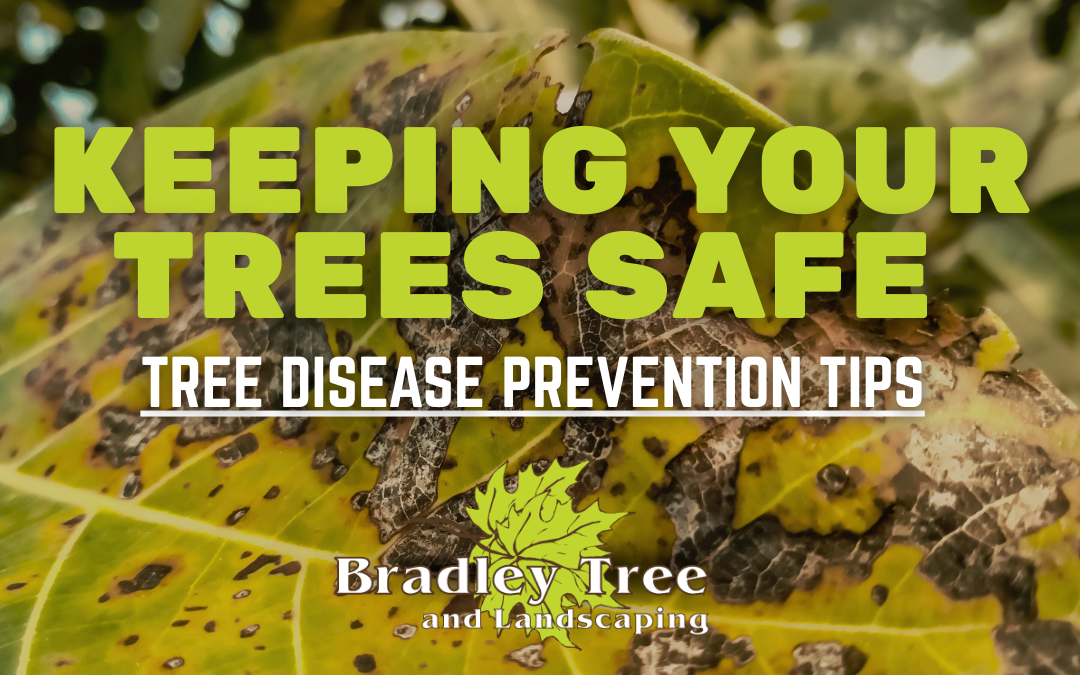Spring is one of the most prominent times of the year when trees start to develop diseases, leading to weakened structural integrity, reduced nutrient and water uptake, and even the worst-case scenario of a dead or dying tree.
At Bradley Tree, while we specialize in the tree removal business, we also specialize in tree maintenance. Taking care of your trees is very important to us before they get to the point where we will need to be called to remove them. Tree diseases are one of the leading causes of this, and in this blog, we will detail multiple ways to look out for these diseases.
How Do Diseases Kill Trees in the First Place?
How can diseases even lead to the death of a tree? In the simplest way of explaining, diseases remove the fundamental building blocks that make a tree what it is. We just mentioned a few of them with something like reduced nutrient and water uptake, preventing the tree from growing. Without bark, it loses its structure and can’t protect itself. All of these situations might lead to death.
Some of the most common killers of trees relate to things like human-based activities of pollution or purposeful deforestation, adverse environmental conditions, or disasters that wipe them out, and of course, diseases of all kinds. Diseases are one of the scenarios that we can control in terms of where and how much they spread, and they can be prevented as well.
A proper inspection from a professional arborist (tree care specialist) will come in handy for this process when telling you how to prevent it, and we can’t recommend enough that you reach out to Bradley Tree for help!
Different Types of Tree Diseases to Look For
Many different kinds of diseases can affect different kinds of trees. New York is home to many diseases that make their way to WNY, including Dutch Elm Disease, Oak Wilt, Anthracnose, Cedar-Apple Rust, Leaf Blight, Powdery Mildew, Root Rot, as mentioned already, and Hemlock Woolly Adelgid.
We recently posted a blog discussing what to look for on Hemlock trees in WNY. Hemlock trees are very abundant in this part of the state, and something like Hemlock Woolly Adelgid is rampant in their potential death.
The rest of the diseases on this list all have their varying effects, such as being composed of fungi, weakening due to periods of high humidity, which sometimes can be present in Spring and Summer, and invasive insect species.
What You Can Do to Look for These Diseases
Here are several signs of a potential tree disease that you can utilize when examining your trees for certain disease effects and what causes them:
Dead or Dying Branches – If you notice any specific areas of the tree that are showing signs of brittle, dead, or drooping branches, this could be a sign of tree disease. It’s springtime! The tree should be flourishing with new growth; if it is not healthy, there’s probably a problem.
Leaf defoliation or reduced foliage – Can be caused by simpler things, such as overwatering or heat stress, but foliage can be reduced due to those hidden pesky insects (all of this can also show a sign of yellow color in the leaves). Keep an eye out for a tree that isn’t producing new leaves or has fewer leaves than usual. No leaves at all is certainly a sign of trouble. Any discoloration or wilting of leaves is problematic in the spring.
Tree bark foliage – In this instance, you will notice effects like cracks, cankers, peeling, or discoloration. It’s possible to view this in only one section of the tree, but it may also cover an entire section. Sometimes trees tend to lose bark naturally, but this is one of the many ways it does so unnaturally. Black lesions can indicate a sign of bacterial or fungal infection.
Fungi or root rot – A person’s basic instinct might be to think that fungi are good for trees, but it’s something that people want to avoid any contact with. For trees, most of the time, it’s the opposite effect. We mentioned how diseases can affect the fundamentals of how a tree grows, and fungi can do that. Root rot is the same as how something as simple as overwatering your trees can cause root rot, leading to a lack of oxygen in the soil and the roots being misplaced.
Weather/temperature-related effects – What the weather and temperature are on a given day isn’t always something you can prepare for, but it is something you can log if it becomes consistent in one type of scenario, such as high humidity or rainfall that causes flooding and erosion. That can cause diseases such as root rot and reduced foliage. If we see extremely dry temperatures, this can also show signs of wilting or dead, or dying branches.
We want you to be as prepared as possible when handling any potential situation that comes your way when assessing your trees. By staying vigilant for early warning signs or ones that are already present on your trees, you can keep them healthy and thriving all season long.
If you would like an evaluation of your tree, just give us a call or reach out to us via our contact form. We will provide an understanding of what’s going on through a consultation with one of our tree experts. We work with home and business owners all over WNY to help save their trees! We look forward to working to save yours!

